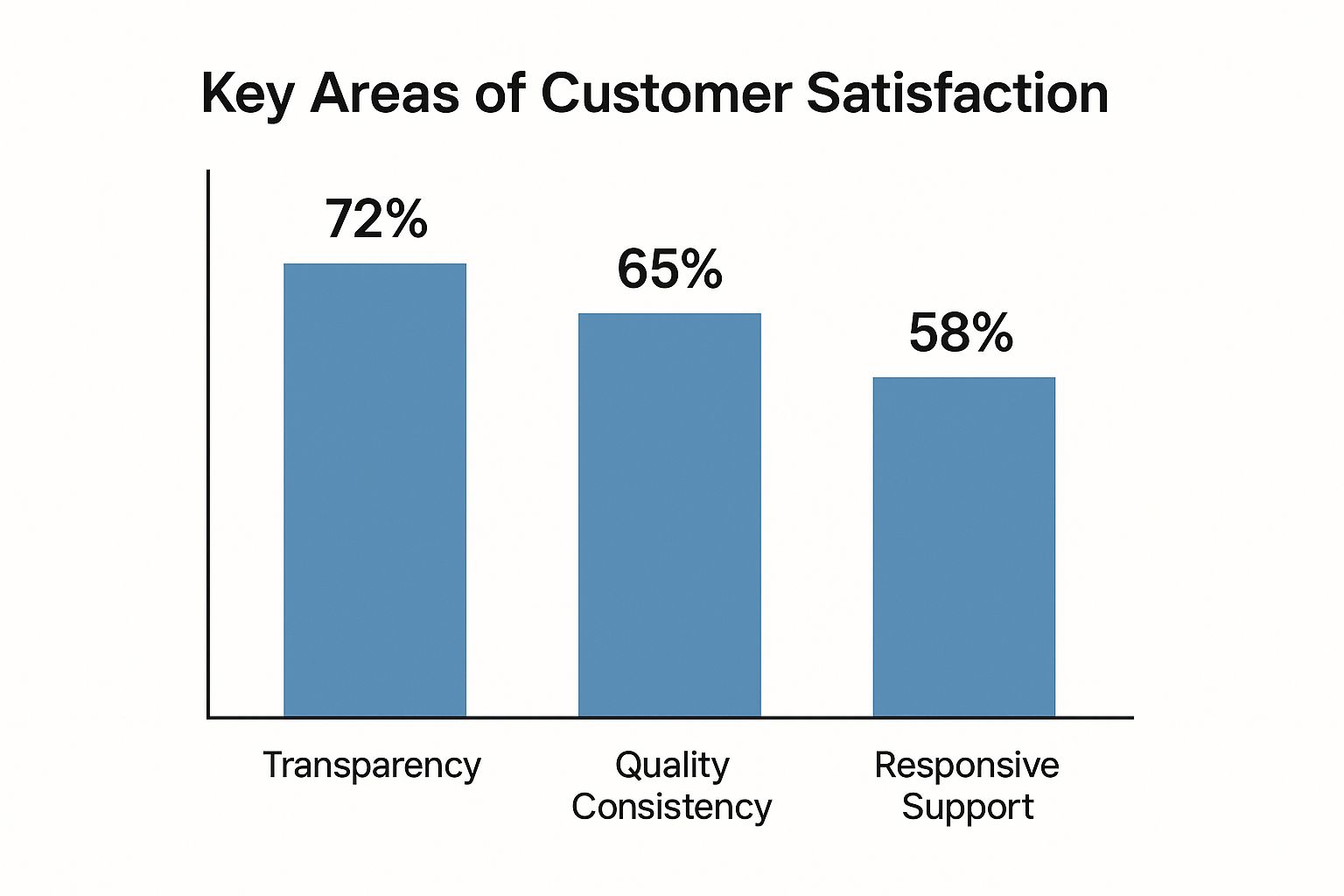The Real Foundation of Customer Trust Today
Trust is the bedrock of any thriving business. It’s no longer a bonus, but a core driver of success. In our interconnected world, customer trust directly impacts key metrics like customer retention, brand advocacy, and customer lifetime value. This emphasizes the need for businesses to adapt to evolving customer expectations around transparency and accountability.
Why Traditional Trust-Building Methods Fall Short
Traditional methods of building trust often relied on superficial tactics, such as catchy slogans or celebrity endorsements. Today’s consumer is more discerning, demanding authenticity and genuine value. Simply claiming a commitment to quality isn’t enough. Customers want proof through transparent practices and demonstrable results. This pushes businesses to adopt more comprehensive and robust trust-building strategies.
The Primacy of Data Protection
How companies manage customer data significantly influences customer trust. A 2024 survey across 31 countries and territories found that 83% of respondents believed data protection was crucial for building trust. This highlights the importance of robust data security measures for companies. Interestingly, only 61% of respondents prioritized a company’s financial performance in the context of trust, underscoring the primacy of data protection. Explore this topic further. This signifies a shift in consumer priorities, placing data security at the forefront.
From Transactions to Relationships
The focus has shifted from transactional exchanges to nurturing long-term relationships built on trust. Businesses must go beyond simply meeting immediate needs and cultivate genuine connections by demonstrating consistent reliability and transparency. It’s similar to building a friendship – trust develops over time through shared experiences and consistent positive interactions. This necessitates a fundamental shift in business approaches, prioritizing genuine engagement and long-term relationship building.
Data Protection That Actually Builds Confidence

Building customer trust isn’t just about saying you prioritize data protection. It’s about showing it. This means taking concrete actions and communicating transparently with your customers. Your organization needs to treat data protection as a core business principle, not just another box to check for compliance. Customers want to know you value their privacy as much as they do.
Auditing Your Current Practices
Knowing where you stand is the first step. A comprehensive audit of your current data protection practices is crucial. This involves examining how you collect data, how you store it, who has access to it, and what your incident response plan looks like. Ask yourself important questions: Are you collecting only the necessary data? Is it stored securely? Identifying vulnerabilities early allows you to address them proactively, minimizing breach risks and showing your commitment to ongoing improvement.
Transparent Data Policies That Customers Understand
Privacy policies filled with legal jargon can be confusing. Instead, aim for clarity and simplicity. Use plain language to explain what data you collect, why, and how you use it. Offer clear opt-in and opt-out choices for data collection and usage. This empowers customers and builds trust by giving them control over their data.
Communicating Your Commitment to Privacy
Talking about your data protection efforts should be a regular practice. Keep your customers informed about your security measures, enhancements, and any policy changes. Consider blog posts, newsletters, or social media updates. Consistent communication reinforces transparency and builds stronger customer relationships.
Rebuilding Trust After a Breach
Even with the strongest security, breaches can happen. How you react will determine whether you keep or lose customer trust. Be proactive, transparent, and communicative during a breach. Explain what occurred, what you’re doing to fix it, and how you’ll prevent future incidents. This shows accountability and a willingness to learn from mistakes.
Data Protection Measures and Their Impact on Customer Trust
To understand how customers view various data protection efforts, let’s look at some recent survey data. The data chart below visually represents customer responses regarding the importance of different security measures, rated on a scale of 1 to 5, with 5 being most important.
- Strong Passwords (4.8): The chart highlights the high value customers place on strong password policies, emphasizing the expectation of basic security hygiene.
- Two-Factor Authentication (4.6): The high rating for two-factor authentication underscores the importance of multi-layered security approaches.
- Data Encryption (4.5): Data encryption is nearly as important as strong passwords and two-factor authentication, showing customer awareness of protecting data at rest and in transit.
- Regular Security Audits (4.2): Regular audits are highly valued, indicating customer expectations for proactive vulnerability management.
- Transparent Privacy Policies (4.0): While important, the slightly lower rating suggests the need for not just having clear policies, but making them easily understood.
The following table provides further details on data protection measures and their impact on customer trust:
| Protection Measure | Implementation Difficulty | Trust Impact | Customer Visibility |
|---|---|---|---|
| Strong Passwords | Low | High | High |
| Two-Factor Authentication | Medium | High | High |
| Data Encryption | Medium | High | Medium |
| Regular Security Audits | High | Medium | Low |
| Transparent Privacy Policies | Low | Medium | High |
This table summarizes key strategies and their relative difficulty to implement, impact on customer trust, and whether customers are generally aware of these measures. As you can see, some measures like strong passwords are easy to implement and have a high impact, while others like regular security audits are less visible to customers but still contribute to overall trust.
This data shows the strong link between effective data protection and building customer trust. By focusing on these key areas and communicating transparently, you can turn data security into a competitive advantage.
Service Excellence That Earns Genuine Loyalty

Exceptional service is the cornerstone of building customer trust. It’s not just about fixing problems; it’s about creating positive experiences that solidify customer relationships. These interactions, when handled thoughtfully, build trust and demonstrate a genuine commitment to the customer.
Training For Trust-Building Interactions
Leading companies invest in training their teams to handle every customer interaction with care, whether it’s a simple question or a complex complaint. This means giving teams the skills to actively listen, empathize, and offer personalized solutions. Imagine a customer frustrated by a late delivery. A well-trained representative will apologize and proactively offer a solution, such as expedited shipping or a discount on their next order.
The Power of Feedback Systems
Robust feedback systems are crucial for building trust. They show a willingness to listen, learn, and improve. These systems allow customers to share concerns and provide valuable insights. Responding to feedback, both positive and negative, shows customers that their opinions matter. This builds a collaborative feeling and shared ownership of the customer experience.
Personalization and The Human Touch
Personalized service is essential. Customers want to feel valued as individuals, not just another number. This involves tailoring interactions to their specific needs and preferences, like remembering past purchases. This personal touch moves beyond automation and shows genuine care.
A recent PwC survey from early 2024 highlighted the importance of customer service in building trust. Protecting customer data was identified as the key factor. Quickly resolving customer concerns was also vital for 74% of respondents. This emphasizes the role of prompt and effective customer service in maintaining trust. For a closer look at these statistics, visit: PwC’s 2024 Trust in Business Survey
Balancing Technology and Human Connection
While automation can boost efficiency, the human element in customer service remains essential. Finding the right balance between technology and human interaction is key. Chatbots can handle basic inquiries, but complex issues often require human empathy and problem-solving skills. This human touch builds rapport and strengthens relationships, ultimately fostering trust.
Creating Digital Experiences That Feel Trustworthy

Your digital presence is often the first point of contact with your brand. This initial online interaction can significantly impact how customers perceive your trustworthiness. Building that trust requires careful consideration of design, security, and user experience. Just as a physical store meticulously arranges its displays and maintains a clean environment, your website and online platforms should project professionalism and reliability.
Design Elements That Inspire Confidence
Certain design elements can subtly communicate trustworthiness. A clean, modern design with clear navigation creates a sense of order and professionalism. On the other hand, a cluttered or outdated site can appear unprofessional, potentially raising red flags for visitors.
High-quality images and videos also contribute to the perceived value and credibility of your brand. These elements demonstrate attention to detail and a commitment to providing a positive customer experience.
Security Indicators That Reassure
Visible security measures can significantly boost customer trust. Clearly displayed security badges, like SSL certificates, and the use of secure payment gateways reassure customers that their information is protected.
Providing clear and concise information about your data privacy policies further builds trust. This transparency demonstrates a commitment to protecting customer data and reinforces responsible data handling practices.
Interaction Patterns That Build Rapport
How users interact with your digital platform is crucial for building trust. Quick loading times and a mobile-friendly design show respect for the customer’s time and improve the overall user experience.
Clear calls to action and easily accessible customer support channels allow for easy navigation and problem resolution. This accessibility fosters confidence and encourages engagement.
The Growing Importance of Digital Trust
The digital experience has become increasingly important in earning and maintaining customer trust. A 2022 Adobe survey of over 12,000 global consumers found that digital experiences were just as important as in-person experiences in building trust. This was particularly true for younger demographics like Gen Z and Millennials, who often find digital interactions even more critical. For more details, see the complete Adobe Trust Report. This trend underscores the need for companies to prioritize their online presence as a key element in building strong customer relationships.
Balancing Automation and Personalization
While automation can streamline processes, maintaining a human touch is vital. Personalized recommendations and relevant content show that you understand your customer’s needs and preferences. This creates a more engaging and relevant experience, fostering stronger connections.
However, this personalization should never feel intrusive. Finding the right balance between automation and personalized interaction is crucial for establishing genuine trust. Think of it like a helpful shopkeeper who remembers your preferences – it builds rapport and loyalty.
Transparency That Transforms Customer Relationships

Transparency is more than just honesty. It’s a vital tool for building strong customer trust. Leading companies use open communication to create deeper connections with their customers, changing how they interact and fostering loyalty. This involves choosing what information to share, when to share it, and how to share it effectively. It’s about building a bridge of clear communication that connects a business with its customers.
Open Communication About Products, Pricing, and Policies
Being upfront about your products, pricing, and policies builds confidence with your customers. Explain clearly how your products work, including both the benefits and limitations. Be honest about your pricing, avoiding hidden fees or confusing jargon. For example, if you offer different subscription levels, clearly outline what each one includes. Make your policies easy to understand by presenting them in simple language. This straightforward approach removes the guesswork for customers, building trust and a sense of security.
To illustrate further, let’s explore some practical transparency practices and their impact on customer trust.
To that end, here’s a helpful table:
“Trust Building Through Transparency: Practices and Outcomes”
This table illustrates effective transparency practices and their impact on customer trust metrics.
| Transparency Practice | Implementation Approach | Customer Trust Impact | Common Challenges |
|---|---|---|---|
| Product Information | Detailed explanations of product features, functionalities, and limitations | Increased customer understanding and confidence in product choices | Difficulty in simplifying technical details |
| Pricing Structure | Clear and accessible pricing information, avoiding hidden fees or complex terms | Enhanced customer perception of fairness and value | Balancing price transparency with competitive pressures |
| Company Policies | User-friendly presentation of terms of service, return policies, and other key policies | Reduced customer anxiety and improved customer experience | Keeping policies up-to-date and relevant |
| Mistake Handling | Openly acknowledging and addressing errors, providing explanations, and outlining corrective actions | Strengthened customer relationships through demonstrated accountability | Overcoming internal resistance to admitting mistakes |
By implementing these transparent practices, businesses can significantly impact customer trust metrics, though challenges certainly remain.
Addressing Mistakes and Building Stronger Bonds
Transparency also means taking ownership of mistakes. When something goes wrong, address it directly and honestly with your customers. Explain what happened, what steps you’re taking to fix the problem, and what you’ll do to prevent similar issues in the future. This demonstrates accountability and a commitment to continuous improvement. It also shows customers you value their experience enough to be truthful, even when it’s difficult. This can actually strengthen your relationship with customers, turning a negative experience into a moment of deeper connection.
Defining Transparency Boundaries
While transparency is important, it’s essential to establish boundaries. Sharing every single detail isn’t always beneficial or even necessary. Some business information, such as proprietary data or sensitive financial information, requires protection. Successful companies find a balance between sharing enough to build trust while safeguarding necessary information. This involves carefully considering what information truly benefits customers and what information is crucial to protect for the business. It requires a delicate balance.
Building a Culture of Transparency
True transparency isn’t a one-time event; it’s a continuing commitment reflected in your company’s culture. Encourage open communication both internally within the company and externally with customers. Empower your employees to be honest and open with customers. This cultural shift helps ensure that transparency is woven into every customer interaction, creating authentic, trust-based relationships. When transparency is part of a company’s fundamental values, it becomes a natural part of doing business, leading to stronger connections with customers.
Reliability That Customers Can Count On
Consistency is key to building customer trust. Maintaining reliable experiences, however, becomes more challenging as your business expands. This section explores how successful companies establish systems that ensure dependable experiences at every customer touchpoint. This includes implementing clear frameworks, robust training, and effective communication strategies.
Setting Clear Expectations and Consistently Meeting Them
Establishing clear customer expectations is the first step. Be upfront about what customers can expect from your products or services. This clarity sets the foundation for a positive customer experience.
Then, focus on consistently meeting, or even exceeding, these expectations. Even as your business grows, this consistent performance reinforces reliability, fostering trust and loyalty. For example, if you promise same-day shipping, make sure your logistics systems can reliably deliver.
Maintaining Quality Through Training and Standards
Effective training programs and clearly defined performance standards are essential for consistent quality. These tools empower your team to deliver reliable service at every level.
Think of a restaurant where every chef is trained to the same high standards. This ensures a consistent dining experience for everyone. This principle applies to any business. Well-trained staff, following established procedures, create predictable and positive outcomes that build customer trust.
Building Redundancy and Proactive Communication
Redundancy in critical systems acts as a safety net, ensuring reliability even during unexpected disruptions. Having backup servers, for instance, can prevent downtime during a technical failure.
Proactive communication is also vital for managing service disruptions effectively. If a problem arises, inform your customers promptly. Explain the situation and outline the steps being taken to resolve it.
This open communication minimizes frustration and demonstrates a commitment to transparency, further strengthening trust, even in difficult situations. It’s similar to a pilot informing passengers about turbulence. Honest communication builds confidence, even amidst uncertainty.
Measuring Trust: Metrics That Actually Matter
Building customer trust is an ongoing journey. Measuring your progress is essential for understanding how customers truly feel about your brand. This means looking beyond typical customer satisfaction surveys to gain deeper insights into their confidence. It’s like checking your financial health – you wouldn’t just look at your bank balance; you’d also consider your investments and debts.
Beyond Satisfaction: Key Trust Indicators
Traditional satisfaction surveys often miss the nuances of trust. For a complete picture, consider these key indicators:
- Customer Retention Rate: A high retention rate shows that customers trust your brand enough to stick around. This is a vital metric because keeping existing customers is often more efficient than acquiring new ones.
- Net Promoter Score (NPS): NPS gauges customer loyalty and their likelihood to recommend your brand. A high NPS reflects strong customer confidence in your offerings.
- Customer Lifetime Value (CLTV): CLTV estimates the total revenue expected from a single customer throughout their relationship with your business. A higher CLTV often signifies strong, trust-based relationships.
- Willingness to Share Personal Information: How comfortable customers are sharing their personal information directly reflects their trust in your data security practices. This is a powerful indicator of the confidence they place in your brand.
- Forgiveness of Minor Mistakes: Observing how readily customers forgive small errors or service hiccups reveals their underlying trust and loyalty. This resilience speaks volumes about the strength of your customer relationships.
For instance, if customers quickly overlook a slightly late delivery or a temporary technical issue, it suggests a high level of pre-existing trust.
Establishing Trust Baselines and Improvement Targets
Begin by assessing your current trust levels. These baseline metrics provide a foundation for tracking improvement. Next, set realistic improvement goals aligned with your industry and business model. Just as a musician sets practice goals to improve their skills, businesses must define measurable steps to build trust. These targets should be specific, measurable, achievable, relevant, and time-bound (SMART).
Segmenting Trust Analysis for Targeted Improvements
Different customer segments may have varying trust levels. Segmenting your analysis helps identify these differences. For example, loyal, long-term customers may demonstrate higher trust compared to newer customers. Understanding these variations allows for the development of targeted strategies, focusing your trust-building efforts where they have the greatest impact. This allows you to personalize your approach, addressing specific needs and concerns within each customer group.
By using these frameworks to measure and track customer trust, you can cultivate stronger customer relationships. This directly contributes to tangible business growth and a loyal customer base.




Leave a Reply